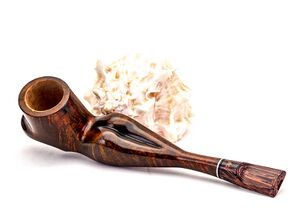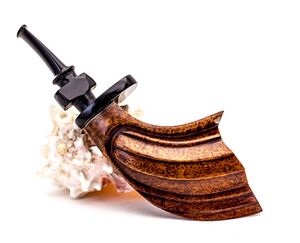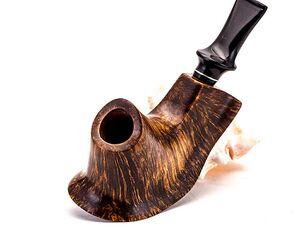Kharitonov
Andrey Kharitonov (Russian: Андрей Харитонов) was born in 1961 in Moscow, Russia, where he still lives today. He was gifted his first pipe on his 20th birthday, which was made from cherry wood by his brother. From then on, he was never without a pipe.
During the many decades that Kharinotov was a pipe smoker, he frequently found himself repairing and restoring pipes. Like many pipe makers, Kharitonov’s introduction to the craft came from making replacement stems, repairing shanks, and refinishing stummels. Following in his brother’s footsteps, Kharitonov also experimented with making his own pipes out of cherry wood.
By chance, in 2019 Kharitonov discovered a Moscow-based store that sold briar from Manno in Italy. He bought his blocks of briar later that year and set about making his first briar pipes.
Despite his years of experience with pipe repair, when Kharitonov first began making briar pipes, he did not possess a workshop to make them in; nor did he have the traditional tools used in the craft. This limited his ability to reproduce standard European pipe shapes. According to Kharitonov,
“My first pipes had nothing to do with classical forms. Classical forms were created for processing on a lathe, but at that time I did not have a lathe. I had practically no tools necessary for making pipes. There were a few files, a couple of narrow wood chisels, and sandpaper bought from a nearby hardware store. There was also no workshop. I would come home from work, sit in the kitchen and start working.”
These constraints on Kharitonov’s pipe making yielded surprising results. His earliest pipes show an experimentalist approach to form, coupled with a clear talent for bringing out the best of what a block of briar has to offer. But when Kharitonov shared his pipes on a Russian pipe smokers’ forum, his audience was, according to Kharitonov, not impressed. He encountered another problem concerning his pipe making, expressed in the form of a question from another user:
“Who do you make your pipes for? For pipe smokers or pipe collectors?
If for smokers, then almost all of your smoking pipes are not suitable, for one simple reason. They are uncomfortable and impossible to hold in your hand. Look at your ‘Mermaid,’ ‘Goby,’ ‘Orange,’ and so on – these pipes do not have a comfortable position in the hand and therefore the average smoker is unlikely to ever buy them. If you make pipes for collectors, then there are no miracles in the world. First you must earn a name for yourself and become a famous master. Only then can you possibly get to selling pipes to collectors. You must decide for yourself what audience you will work for.”
This feedback encouraged Kharitonov to rethink his approach to pipe design, but it did not discourage him from continuing to explore unique and elaborate forms. He was strongly inspired by the work of other Russian pipe makers, such as Victor Yashtylov, Michail Revyagin, and Alexey Kharmalov – pipe makers who Kharitonov feels an affinity with because they all “think in the same language.”
Soon Kharitonov’s pipes began to find a market. By the end of 2020, he had made 50 pipes, using the proceeds from their sales to purchase dedicated pipe making equipment. During 2021, he made 110 pipes, and had started receiving enough commission requests to quit his job and become a full-time pipe maker. He has continued to make pipes as a full-time job ever since. Despite his successes, Kharitonov says that he his style in search of his own style. “My only regret is that I didn't start making pipes 15-20 years earlier”, he says.
Kharitonov typically makes his stummels from Calabrian briar and his stems from SEM ebonite. To accent his pipes, he sometimes uses inserts made of silver, cupronickel, or exotic woods, but his favorite adornment is fossilized mammoth tusk, which he uses frequently and in unconventional ways. He also loves to work with bamboo.




